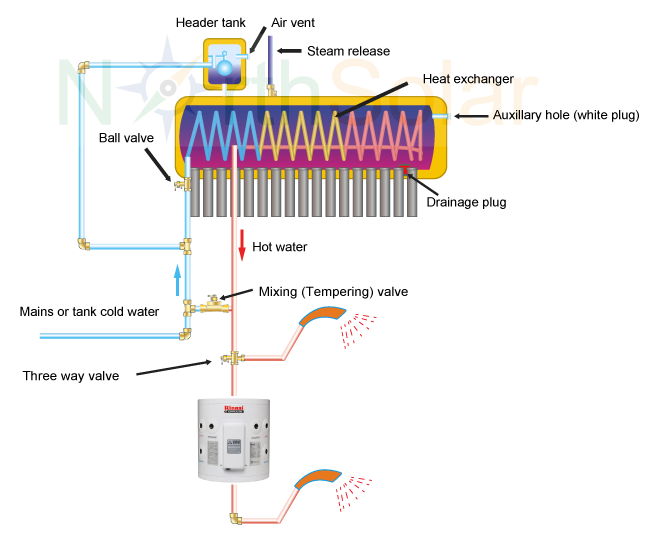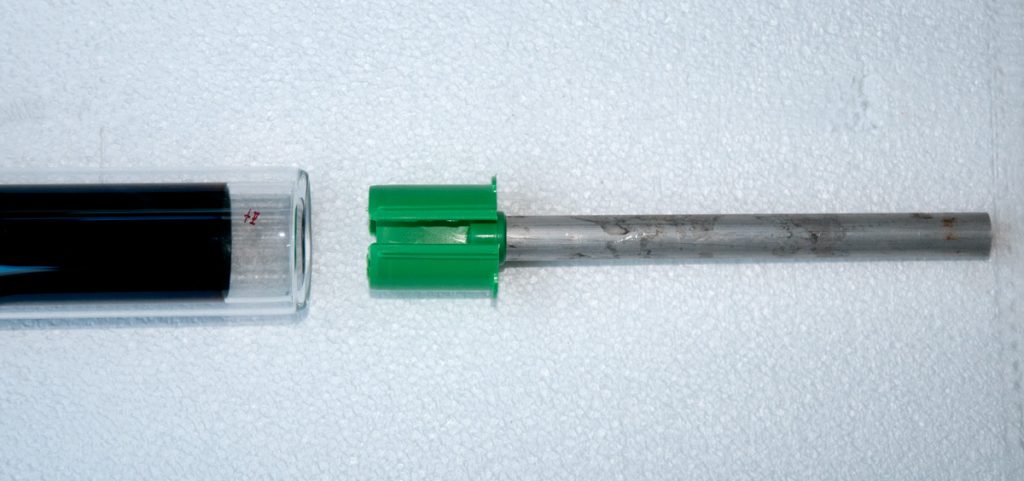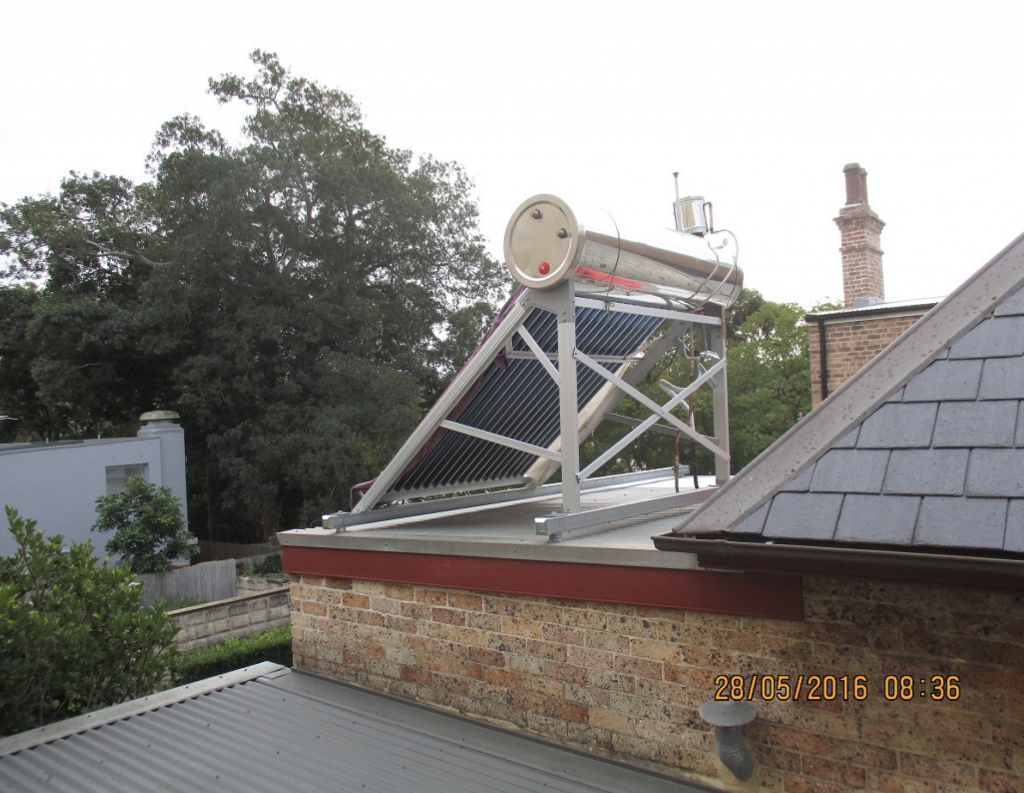NS200WB Full Review – North Solar NS-200WB
Review of North Solar 200WB Hot Water System
Phil – NSW
These things always happen at the worst time. It’s 5.30 am on a Tuesday morning in early May 2016 and I am walking up the driveway when I notice an unnatural shine from the brickwork on the sidewall of the house. A quick glance upwards reveals water running out the overflow pipe for the hot water service that is located in the roof cavity. A quick trip up to the roof cavity reveals that my circa 1967 Langco gravity feed 80 Gallon ( 320 litre) copper tank hot water service has finally failed. The cause of the failure being a build up of of sediment in the base of the tank has corroded the tank and caused it to leak. So, after shutting off the water feed to the Hot Water Service and draining the tank, it’s time to commence the due diligence for a replacement.
Owing to the spacing of the ceiling joists and the slate roof, another ceiling cavity mounted system is out of the question. With rear of the property having a North Westerly aspect and good solar access, the logical choice is for a Solar Hot water System, the only question is which one. The first one that springs to mind is a SolaHart system – a long established company with a good track record, so a quick phone call arranges a site inspection from one of their sales partners. The cost estimate for a 302 litre system with flat plate solar collectors comes in at $4,800 installed, with a few important points. Firstly, with the slate roof, the installer would not be able to run the water supply and return from inside the roof cavity to the outside position located on the kitchen roof at the rear of the property – I would need to have a roofer remove and re install the bottom few courses of slates so that the plumbing and electricity services could be run out to the new Hot Water System. The SolaHart partner would also not be held liable for any damaged caused as a result of the kitchen roof structure being unable to handle the roof loading of the new system. “How much roof loading?” Well to give you a ball park figure, the weight of the system would be just over 500kgs ! The thought of being in the kitchen cooking breakfast and suddenly having a 500kg hot water tank containing hot water at 65 deg C suddenly dropping on your head was not a very pleasant thought. So suddenly the idea of a roof mounted hot water system is looking a little expensive.
The other options were to have a 300 litre Electric Hot Water System located in the side driveway or at the back of the house – an option that took up valuable floorspace and was aesthetically very unpleasant. Why not go for a smaller system – Solahart make a 181 litre system. Well, after asking a few questions about the smaller system, I was encouraged to avoid the 181 litre system – the main reason being that a 181 litre system, when electrically boosted as would be the case in winter does not deliver 181 litres of hot water. In fact, it only delivers approx 90 litres, approx 50% of it’s capacity! The same story with the 302 litre system, 150 litres – 50% of it’s capacity. The other draw back of the Solahart system that emerged was that the storage tank was cast iron, and the hidden cost of a 5 year service of $500 in today’s dollars, were making this system somewhat undesirable.
A trip to another major Hot Water Service company who sells systems and parts and handles installs suggested another brand – this one used a stainless steel tank, 300 litre capacity, flat plate collector and didn’t have the same 5 year service costs as the Solahart system. The quote came in just slightly cheaper at $4,700, But again on the provision that I ran the water and electricity out to the new system and I was responsible for the integrity of the roof structure that would carry the load. So being no closer to a solution and getting just a little fed up with boiling the Kettle and using a 12 litre watering can to shower twice day, I started surfing the internet for alternatives, and ended up on Ebay, as one inevitably does! The discovery of a 200 litre evacuated tube Hot Water System caught my eye.
This system ticked all the boxes for me – Australian Company, Evacuated Tube System, Stainless Steel Tank, Electrically Boosted System. A bit more research into evacuated tube systems revealed two different types – evacuated tubes with heat pipes and a more basic open system. The North Solar 200WB was an Open System – a very basic design.
So How does it work?
Well the evacuated tubes and the 200 litre Stainless Steel tank are filled with water. This water is heated up by the sun in the evacuated tubes and, as the water heats up, it travels upwards into the 200 litre tank. The water that is displaced from the evacuated tubes is replaced by water in the Stainless Steel tank, essentially a thermosyphon system. Running through the Stainless Steel tank is a long coil of 12mm copper pipe – Approx 25 metres in length. This copper coil is a heat exchanger. The water that turns up at the tap in your bathroom is NOT the 200 litres in the Stainless Steel tank, but is water under mains pressure that flows through the copper coil, heating up as it travels through the copper coil. The water in the Stainless Steel tank is only under atmospheric pressure, and not under mains pressure – the benefits are that firstly, the Stainless Steel tank is not a pressure vessel so it can be made of lighter gauge material reducing weight and more importantly, as it is not under pressure it will last much longer ( unlike other Hot Water Systems where one of the main contributing factors in tank failure is the pressure in the tank).

So, as previously stated, a very basic system – with not much to go wrong! The draw backs are, it is not quite as efficient as a heat tube system ( but very, very close) and, if an evacuated tube breaks, all the water in the Stainless Steel tank will drain out, rendering the system useless ( unlike the heat tube system, which will continue to function). On a side note, on the heat tube system, individual heat tubes can , and do fail and you would be unaware of the fault. They are only discovered by a diminished heating effect of the system.
So after a informative discussion with Andrew from North Solar, I opted to go with the North Solar 200WB system. Wait a second, Am I Crazy?? I am buying a essential piece of equipment for my most expensive investment that is 1/ an unknown brand and 2/ off Ebay. Have I completely lost my mind? Well, I justified it by telling myself that it is 1/3 of the price of the other name brand systems. Besides, I would still have to strengthen up the roof structure and have the plumbing and electrical run out to the system regardless of which system I opted for. So even if the system didn’t work or only lasted for a short time, there were other options to fall back on.
Time to get the tools out!
With the North Solar 200 WB system ordered and on the way, it was time to get to work. The reinforcing of the roof structure was always going to be a major job. The corrugated iron flat roof above the Kitchen that would support the Hot Water System was 150 years old but the timbers were in good condition and solid – back in the day they just chopped the branches off and used the entire tree for rafters or pretty much so, but the big concern was that there was a large window close to the ceiling at one end of the rafters and I was uncertain of the fixing method where they attached to the main building structure at the other end. After much thought and a bit of discussion with an engineer, it was decided the simplest ( and cheapest ) way to ensure that the roof would support the weight was to not use the roof, but to run 2 large steel supports that spanned across the roof and rested on the brick walls at either side of the roof – a distance of just under 4 metres. Being just above the corrugated iron roof, this had the advantage of being able to replace the roofing sheets at a later date without having to remove and re install the Hot Water System. An easy modification and one I could do without employing a builder – that is if you could find one in Sydney! The routing of the water and electrical supplies proved to be much easier than was envisioned- there was just enough room to drill three holes between the guttering of the main roof and the corrugated iron kitchen roof , and after having done the rough in for the services, a couple of long time mates who just happened to be a plumber and electrician were sweet talked into coming over for a few beers – bring your tools just in case guys!
The installation of the North Solar 200 WB system was pretty straight forward, with a couple of exceptions. The frame was assembled at ground level and then hoisted into position. The instructions stated to ensure that the frame bolts are left loose until AFTER the Stainless Steel tank is mounted. I thought that I had left them loose enough and tried to install the Stainless Steel tank – only to find that it would not fit. The frame seemed too short by about 25mm. Back on the phone to Andrew at North Solar late on a Saturday afternoon. “ Make sure that ALL the frame bolts are loose, it will fit!” No way I thought! But we’ll give it another go. Sure enough, Andrew was right. The only thing that I didn’t like about the frame was that the frame bolts did not have washers. Having a mechanical Review of North Solar 200WB Hot Water System background, I was taught that bolts and nuts should always have washers.
There may have been an engineering reason why the frame was not supplied with washers that I am unaware of, but my training got the better of me and I invested in a box of stainless steel washers for my own piece of mind.
With the System installed, there was a wait for approx 1 week for the Sacrificial Anode – they were on back order at the time of delivery. The Sacrificial Anode is a small magnesium rod that is inserted into one of the evacuated tubes. It is designed to corrode away over time via electrolysis, thus saving the Stainless Steel tank from corroding.

The Sacrificial Anode is a service item that should be replaced at regular time intervals – this is not unique to the North Solar 200 WB system – in fact most Hot Water Systems have these, but most people don’t bother replacing them with the inevitable result of a reduced lifespan of their Hot Water System.
1 year on
So what is it like to live with? Were my fears of a non name brand Hot Water System bought off Ebay justified? I can describe the system in just one word – Brilliant!
Today is the 10th of June 2017 and we are, according to the Weather Bureau, having one of those East Coast Lows. This week I have switched on the electrical heating element each morning for 1 hour 15 mins when I get up. The heating element is rated at 2400w – the same size as a portable fan heater. In the 1 hour and 15 mins that it is running each morning, the Stainless Steel tank temperature goes from 40 deg c to 52 deg C (on average) and uses 3 kWh of electricity – at a cost of 28 cents ( off peak). This is enough to give me a 5 min hot shower in the morning, do the washing up after breakfast and dinner and another 3 min hot shower in the evening. Since Early June 2016 when I installed the system, I have used the electrical heating element for 5 days this week and for 1 day in March. A grand total of 6 days out of 370 days and an electricity usage of
18kWh. By comparison, my old Lango system used on average 800kWh per quarterly electricity bill – 3,200kWh per year.
After Sales Support from North Solar
During the purchase and delivery of the system , I have communicated with Andrew from North Solar several times both via email and telephone. I have also contacted Andrew with some other technical questions since and have found him to be very helpful and true to his word. The delivery of the North Solar 200WB system and Sacrificial Anode was prompt and I was kept informed when the items were dispatched from Victoria.

The Cost
The total cost of the system including installation came in at just on $3,000. This included the North Solar 200WB system, the Frame, Heating Element, Sacrificial Anode, Installation Kit, Freight from Victoria to Sydney, additional copper tubing and associated plumbing supplies to extend the water service to the new system, associated electrical costs for wiring, etc , materials for supporting the system over the roof span and the case of beer for the guys.
Things to be aware of
The North Solar 200 WB system is a heat exchanger. Think of walking barefoot on hot sand during summer. The quicker you walk over the hot sand, the less chance you have of burning your feet. So the slower the water flows through the copper coil heat exchanger, the hotter the water will get. This can be achieved by fitting an isolation valve to the water supply to the North Solar 200 WB system and slightly reducing the water flow.
Like every other hot water heater, the further the distance the hot water has to travel from the Hot Water System to the outlet – i.e. the shower, the more heat loss the system will suffer, so ensure that you use good quality insulation on ALL pipes and hoses from the system to the outlet.
The Stainless Steel tank is not a pressure vessel, It was never designed to be a pressure vessel. Under normal operating conditions the Stainless Steel tank is under atmospheric pressure. The long pipe that screws on the top of the Stainless Steel tank is a steam vent.
It is Vitally important that the end of the vent is kept clear of any obstructions. Failure to ensure that the steam vent is not blocked will result in a massive pressure build up inside the Stainless Steel tank which may result in rupturing of the Stainless Steel tank- this is most likely to happen during hot weather when the tank temperature is at boiling.
The system can get very hot! During the middle of summer on very hot days, I have experienced the water in the tank reaching over 93 deg C and spouting boiling hot water out the steam vent ( which is it’s purpose). If you or your pets are near the system when this happens, you or your pets can suffer serious burns. The fitting of a tempering valve is essential. It is also required under law!
As above the tank temperature can reach boiling point ( around 100 deg C ) on hot days. Without a Tempering valve, you will get water temperature this hot at the outlet. This will result in severe burns – especially if you are under the shower when the hot water arrives.
The North Solar 200 WB system weighs 358kg under normal operating conditions. Ensure that the structure that you are mounting the system on is capable of carrying this amount of weight. Don’t forget to factor in additional weight for atmospheric conditions – i.e. wind and snow loads, and also the weight of any person doing maintenance work on the system.
This review is written by Phil Pearce.
The author is not an employee or business associate of North Solar. He has not received any payment in any form of financial or material support from North Solar.


